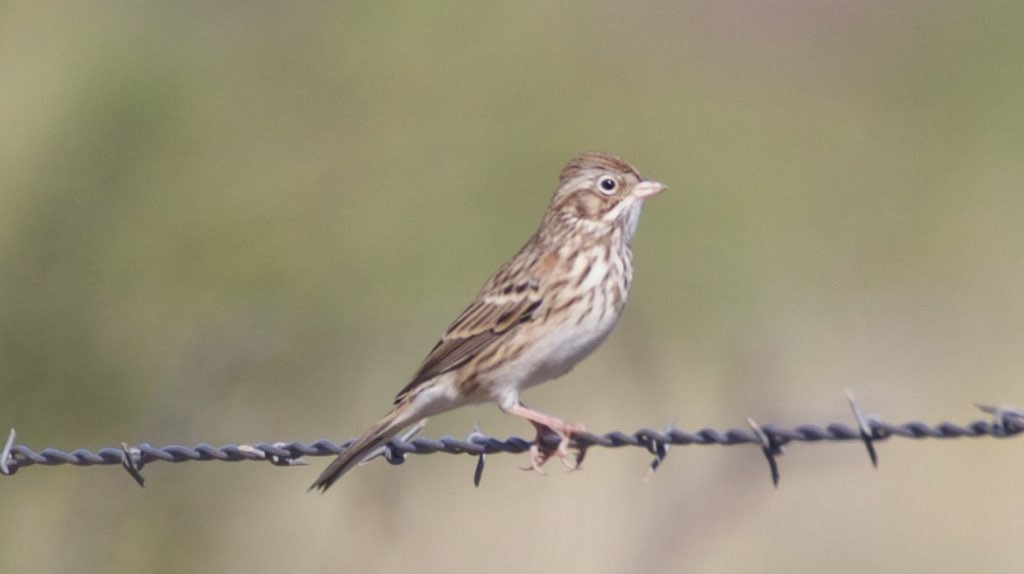Vesper Sparrow
A species of Vesper Sparrows Scientific name : Pooecetes gramineus Genus : Vesper Sparrows
Vesper Sparrow, A species of Vesper Sparrows
Botanical name: Pooecetes gramineus
Genus: Vesper Sparrows
Content
Description General Info
Description
Measurements: Length: 5.1-6.3 in (13-16 cm) Weight: 0.7-1.0 oz (20-28 g) Wingspan: 9.4 in (24 cm) Adults have light brown upperparts and light underparts, both with darker streaking. They have a white eye-ring and a long dark brown tail which shows white outer feathers in flight. Their breeding habitat is open grassy areas across most of North America. The nest is an open cup on the ground under a clump of grass. These birds migrate to the southern and central United States and Mexico. These birds forage on the ground, mainly eating insects and seeds. Outside the nesting season they often feed in small flocks. The male sings from a higher perch, such as a shrub or fencepost, which indicates his ownership of the nesting territory. The musical song begins with two pairs of repeated whistled notes and ends in a series of trills, somewhat similar to that of the song sparrow. This bird's numbers are declining in the eastern parts of its range due to habitat loss. 
Size
14-17 cm (5.5-6.75 in)
Colors
Brown
Black
White
Life Expectancy
7.9 years
Nest Placement
Ground
Clutch Size
2 - 6 eggs
Incubation Period
1 - 3 broods
Number of Broods
11 - 14 days
Nestling Period
7 - 14 days
Feeding Habits
Vesper Sparrow feeds primarily on seeds of grasses, weeds, and grains, obtained through scratching the ground. During breeding season, insects and spiders supplement their diet, picked from low vegetation.
Habitat
Vesper Sparrow primarily inhabit open landscapes such as meadows, fields, prairies, and roadsides. Favoring environments with short, sparse grass and occasional shrubs, they are found in a variety of open areas including pastures, old fields, weedy fencelines, hayfields, and native grasslands. Their geographic range extends to mountain meadows, grassy mesas, and sagebrush steppe, often at altitudes up to 9,800 feet. Both during migration and in wintering grounds, vesper Sparrow seek out habitats with similar characteristics for feeding and nesting.
Nest Behavior
Vesper Sparrow exhibits ground nesting habits. Females construct the nest and lay eggs sequentially; both parents participate in feeding and protecting the young.
Nest Characteristics
Vesper Sparrow's nest is a shallow depression on the ground, concealed under vegetation, logs, or branches. It is built with grasses, sedges, mosses, and bark strips, forming a shallow cup.
Dite type
Insectivorous
General Info
Feeding Habits
Bird food type
Bird Feeder Type

Ground

Platform
Behavior
Vesper Sparrow exhibits distinctive ground-dwelling behavior, actively hopping and running amidst grasses while foraging. Its interaction with the environment includes a unique dual-foot scratching technique to unearth seeds, complemented by regular dust baths that maintain its feather condition. The males display notable courtship rituals, chasing potential mates and integrating aerial song displays into their pursuit. Seasonally monogamous, vesper Sparrow forms paired bonds during the breeding season, later migrating in modest flocks, amalgamating with other sparrow species in shared winter foraging grounds.
Species Status
Not globally threatened.
Scientific Classification
Phylum
Chordates Class
Birds Order
Perching birds Family
New world sparrows Genus
Vesper Sparrows Species
Vesper Sparrow 